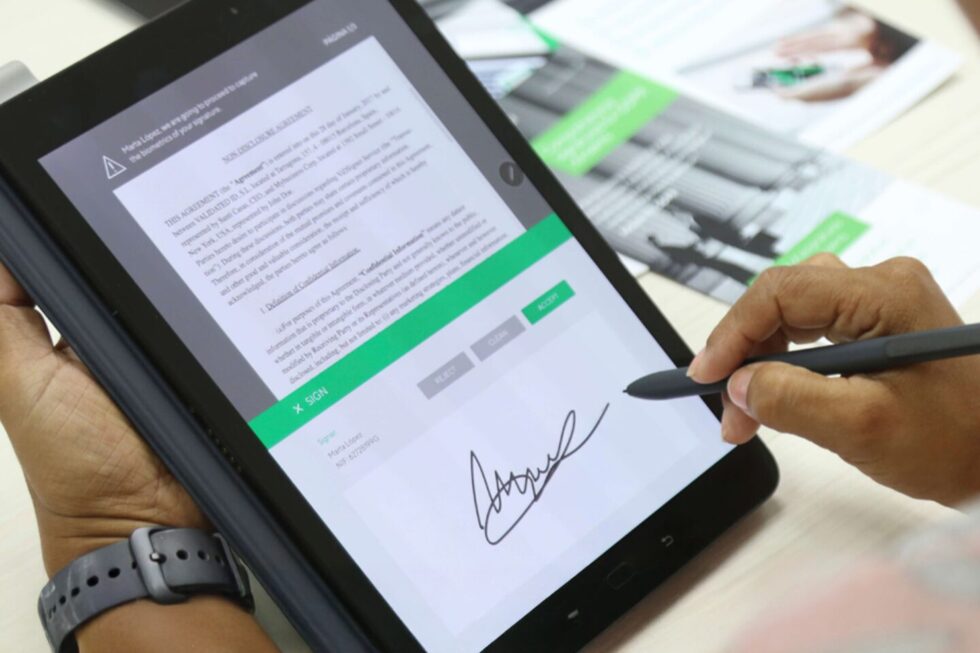E-Signatures vs. Digital Signatures: Which Is Right for Your Business?

Electronic signature adoption has been on the rise among businesses since the Electronic Signatures in Global and National Commerce Act (ESIGN Act) was passed in 2000. With the sudden growth of remote work and emerging pressures to go digital, businesses are struggling to keep pace with the changing global environment. It’s imperative that they figure out how to reduce manual, paper-based processes to maintain productivity.
Electronic record keeping enables businesses to complete their first step toward digital transformation. The ability to electronically sign documents anywhere in the world, crossing borders and barriers of distance, allows signers and originators to exchange agreements within minutes. Electronic signatures help businesses decrease their environmental footprint, greatly reduce costs on paper, and shorten document life cycles.
However, there is still a lack of awareness when it comes to the different types of signature technologies available. For example, the terms electronic signature (e-signature) and digital signature are often used interchangeably, but there are critical differences to understand when choosing the right product for your business.
At a high level, e-signatures are equivalent to signing documents with a handwritten or “wet signature” and are legally binding under certain conditions. They are ideal when users need to indicate the intent to approve or accept the contents of a document such as a contract, invoice, or lease agreement.
On the other hand, digital signatures are a category of electronic signatures that leverage algorithms to generate a unique digital fingerprint. They provide the most secure form of authentication using digital certificates. This extra security ensures signing parties are willfully entering into an agreement, and the agreement cannot be altered after signing.
Continue reading to see the benefits of signature technology and learn innovative ways to streamline daily processes and diminish manual oversight.
E-Signatures
According to the ESIGN act, an electronic signature is defined as “an electronic sound, symbol, or process that is attached to or logically associated with a record and executed or adopted by a person with the intent to sign the record.”
In simple terms, this could be a graphical stamp of your hand-written signature, recorded verbal confirmation, or even your typed name on the signature line of a document.
Indicating an agreement to a contract, e-signatures are legally recognized and legally binding under the ESIGN Act and counterpart Uniform Electronics Transactions Act (UETA). Three main legal conditions must be met, among other best practices:
- Authentication: Confirms the signer’s identity using various methods such as login, SSN, email address, or IP address.
- Intent: A signer shows clear intent to electronically sign an agreement by typing or drawing their signature into a field.
Retention of Records: Records must be retained to accurately reflect the agreement by the business, allowing the signer to download a copy of the signed agreement.
Digital Signatures
Digital signatures are a form of an electronic signature, but not all electronic signatures are digital signatures. Digital signatures ensure electronic documents are authentic and use encryption to verify information has not been altered and is coming from a trusted source.
Complying with strict legal regulations, certificate based digital signatures are the most reliable assurance of a signer’s identity. Digital signers are issued a certificate from a certificate authority (CA), and when a user signs a document, they are assigned a public key infrastructure (PKI), binding their identity to the document.
Creating digital signatures is a complex mathematical process only handled by a computer and is more secure than other forms of electronic signatures.
Which Signing Technology Is Right for My Business?
While there are many benefits to electronic signatures, many companies face hesitation to adopt new technologies. Whether the uncertainty stems from the cost, implementation time, onboarding procedures, or adjusting to a learning curve, convincing the stakeholders that these technologies hold value is crucial for success. In order to remain competitive, organizations should identify tedious processes in their workflows and learn how to solve them with technology solutions.
While both electronic and digital signatures are legally binding, most businesses choose the convenience of electronic signatures. However, since e-signatures are not regulated like digital signatures, it is often up to individual businesses to develop and implement their own application and code to conform to the requirements of authentication, intent, and records retention.
While an electronic signature is a graphical image placed on a document, it can’t show if someone tampers with the document after signing. Digital signatures ensure non-tampering, verification, and independent adherence to standards.
Identifying business drivers and security requirements help determine the appropriate electronic signature technology. Below are questions to evaluate when reviewing the three scenarios described in the following section.
- What is the level of sensitivity, assurance, and required proof of signer authenticity for documents to be signed?
- What processes and workflows does the organization need to design when deploying electronic signatures in their current technology?
- Will there be a need to route documents for additional role signatures and approval signatures?
- Does your organization follow any specific industry standards or compliance providing stakeholders a digital version of documents with certifying signature?
Discover the use cases for digital signatures vs. e-signatures and decide which one is right for your organization in the rest of my article here.
